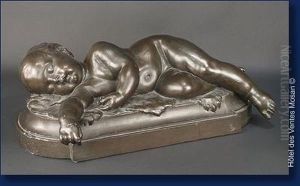Charles Auguste Fraikin Paintings
Charles Auguste Fraikin was a Belgian sculptor born on July 14, 1817, in Herentals, Belgium. He is known for his works in neoclassical style, which was the prevailing artistic movement during his time. Fraikin's sculptures often focused on mythological themes, portraits, and funerary art, reflecting the tastes and intellectual pursuits of the European bourgeoisie in the 19th century.
After initial training in his home country, Fraikin moved to Paris to further his studies and work. In Paris, he was greatly influenced by the Romantic movement, which was then giving way to neoclassicism. Despite these influences, Fraikin maintained a distinct style, characterized by a refined elegance and a focus on the idealized human form, typical of neoclassical aesthetics.
His career was marked by several successes, including the winning of the Prix de Rome in 1841, which allowed him to study in Rome. There, he was exposed to the works of classical antiquity and the Renaissance, which had a lasting impact on his artistic approach. Upon returning to Belgium, Fraikin received numerous commissions, including public monuments and works for private patrons.
One of his most notable works is the 'Gallery of Illustrious Belgians,' a project started in 1842, which includes a series of busts representing prominent figures from Belgium's history. This project reflects the rise of national consciousness in Belgium, which had gained independence only two decades earlier.
Charles Auguste Fraikin's legacy is also marked by his role as a teacher; he became a professor at the Academy of Fine Arts in Antwerp. Through his teaching, he influenced a new generation of Belgian artists. He died on January 6, 1893, in Florence, Italy. His works continue to be appreciated for their craftsmanship and contribution to the neoclassical tradition in Belgian art.
